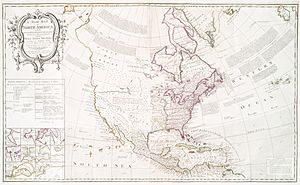Province of Las Californias facts for kids
Quick facts for kids Las Californias
Las Californias
|
|||||||||
|---|---|---|---|---|---|---|---|---|---|
| Province of New Spain | |||||||||
| 1767–1804 | |||||||||
 Las Californias within the Viceroyalty of New Spain |
|||||||||
| Capital | Loreto (1768–1777) Monterey (1777–1804) |
||||||||
| Government | |||||||||
| • Type | Colonial government | ||||||||
| Gobernadores | |||||||||
|
• 1767–1770
|
Gaspar de Portolá (first) |
||||||||
|
• 1800–1804
|
José Joaquín de Arrillaga (last) |
||||||||
| History | |||||||||
|
• Established
|
1767 | ||||||||
|
• Divided into Alta and Baja California provinces
|
1804 | ||||||||
|
|||||||||
| Today part of | United States Mexico |
||||||||
The Province of Las Californias (in Spanish: Provincia de las Californias) was a large area controlled by the Spanish Empire. It was located in the northwestern part of New Spain, which is now Mexico. This province covered a huge territory.
Today, this land includes the entire U.S. state of California. It also covered big parts of Nevada, Utah, Arizona, Wyoming, Colorado, and New Mexico. In Mexico, it included the states of Baja California and Baja California Sur.
Why "The Californias"?
You might wonder why it was called "Las Californias" (The Californias) instead of just "California." This name caused some confusion.
A historian named Theodore Hittell explained it well. He said that a long time ago, people thought California was actually several islands. So, they called it "Las Californias."
Later, they realized it was a peninsula, a piece of land almost surrounded by water. At that point, they just called it "California." But this "California" was a very large, undefined area.
When people started exploring and settling new parts, especially north of the peninsula, they began to call the peninsula "Antigua" (Old) California. The new, unexplored northern areas became "Nueva" (New) California. This new part was later called "Alta" (Upper) California.
So, the old name "Las Californias" came back. But this time, it meant both the "Old" and "New" parts together.
A Look at History
The first attempt by Spain to settle California was in 1683. A Jesuit missionary named Eusebio Kino tried, but his mission failed.
It wasn't until 1697 that another Jesuit, Juan María de Salvatierra, successfully started a mission. This was the Misión de Nuestra Señora de Loreto Conchó. It grew into Loreto, which became the first permanent town and the main administrative center of the province. The Jesuits built many missions, about 18 in total, on the lower two-thirds of the Baja California peninsula.

In 1767, the Jesuits were told to leave their missions. Franciscan missionaries then took over. Gaspar de Portolá was made governor to help with this change.
At the same time, a special official named José de Gálvez came from Spain. He had the power to organize and expand the new province.
The name "Las Californias" was officially chosen in 1768. This was done by Viceroy de Croix and José de Gálvez. Gálvez wanted to show the difference between the "Antigua" (old) settled areas and the "Nueva" (new) unexplored areas to the north.
At first, most of the province was just around the old Jesuit missions. But as more exploration happened in the north, the names Alta (upper) and Baja (lower) became more popular.
In 1804, the single province was divided. It became two separate provinces: Alta California and Baja California. By this time, the "Alta" province had grown a lot. It included coastal areas as far north as what is now the San Francisco Bay Area in the U.S. state of California.
This expansion happened thanks to explorers like Gaspar de Portolá (in 1769) and Pedro Fages (in 1770). Juan Bautista de Anza also led expeditions between 1774 and 1776. Franciscan missionaries and others also helped with exploration and settlement.
When Mexico became independent, it kept the division of Alta and Baja California. However, they were no longer provinces but territories. This was because they didn't have enough people to become states.
Geography of the Californias
The Baja California Peninsula is surrounded by water on three sides. It has the Pacific Ocean to the south and west, and the Gulf of California to the east. Alta California had the Pacific Ocean to its west. Its eastern parts were mostly deserts.
A northern border was set in 1819 by the Adams–Onís Treaty. This border was at the 42nd parallel north. This line is still the northern border for the U.S. states of California and Nevada, and the western part of Utah.
Most of the inland areas were not explored by the Spanish. This meant they were not really controlled by the Spanish government. Large mountain ranges like the Peninsular Ranges, eastern Transverse Ranges, and the Sierra Nevada acted as natural barriers.
The dry Colorado Desert, Mojave Desert, and Great Basin Desert also made it hard for Spanish settlers to move eastward. The eastern border of upper Las Californias was never officially set by Spain or later by Mexico.
However, old government papers from 1781 described Alta California as the areas west of the Sierra Nevada mountains. It also included the lower part of the Colorado River. This river now forms the border between California and Arizona.



